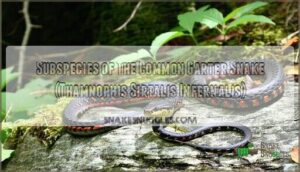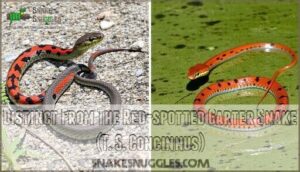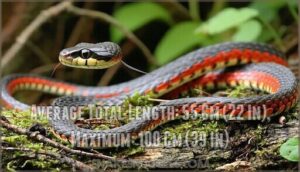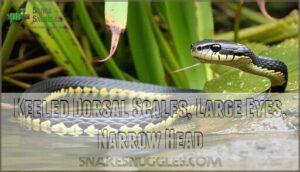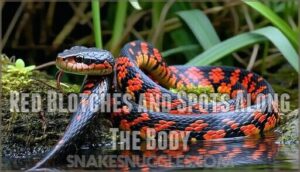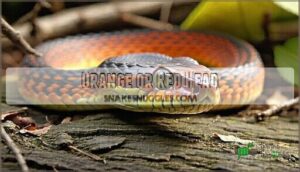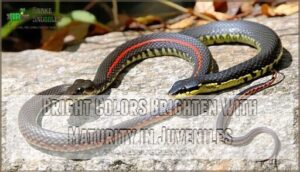This site is supported by our readers. We may earn a commission, at no cost to you, if you purchase through links.

Don’t be fooled by its striking looks—it’ll strike when first handled and release musk as a defensive backup plan. The species faces real conservation challenges with its patchy range from Humboldt to Monterey County, making each population precious.
What makes this subspecies truly notable isn’t just its vibrant appearance, but its specialized hunting strategies that set it apart from its common cousins.
Table Of Contents
- Key Takeaways
- Taxonomy and Appearance of The California Red-Sided Garter Snake
- Unique Features of The California Red-Sided Garter Snake
- Behavior and Diet of The California Red-Sided Garter Snake
- Frequently Asked Questions (FAQs)
- What are the characteristics of a Red-sided Garter Snake?
- Are red-sided garter snakes poisonous in California?
- How big are California red-sided garter snakes?
- What does a California garter snake look like?
- What conservation efforts are in place?
- How long do they typically live?
- Are they found as household pets?
- What predators pose threats to them?
- How many subspecies are recognized?
- How can you distinguish males from females?
- Conclusion
Key Takeaways
- You’ll recognize California red-sided garter snakes by their vibrant red blotches along dark bodies, orange-red heads, and distinctive checkerboard pattern – they’re stunning aquatic specialists averaging 55 cm long with keeled scales.
- You’re looking at an endangered subspecies with fragmented populations from Humboldt to Monterey County, making each encounter precious due to habitat loss and geographic isolation that threatens their survival.
- You’ll find these excellent swimmers are daytime hunters who’ll strike defensively when first handled and release musk, then quickly escape into water using their specialized aquatic adaptations.
- You’re witnessing specialized predators that dive for fish, amphibians, and worms while producing 8-20 live young per clutch, with juveniles developing brighter colors as they mature into their striking adult appearance.
Taxonomy and Appearance of The California Red-Sided Garter Snake
You’ll recognize the California red-sided garter snake by its scientific name Thamnophis sirtalis infernalis, a subspecies that’s distinct from its cousin, the red-spotted garter snake.
When you spot one in the field, you’re looking at a snake that usually measures 55 cm but can stretch to an impressive 100 cm, featuring keeled dorsal scales, large eyes, and that characteristic narrow head that makes identification straightforward.
Subspecies of The Common Garter Snake (Thamnophis Sirtalis Infernalis)
When you encounter California’s red-sided garter snake, you’re looking at Thamnophis sirtalis infernalis—a subspecies that’s carved out its own evolutionary niche. This snake represents Species Adaptation at its finest, breaking free from its common ancestor’s template. Wildlife Preservation efforts focus on this unique lineage because it’s not just another garter snake. It’s California’s own masterpiece of Snake Ecology.
- Scientific classification: Thamnophis sirtalis infernalis (subspecies of common garter snake)
- Evolutionary divergence from widespread Thamnophis sirtalis populations
- Endemic California distribution reflects isolated Species Adaptation
- Critical focus for Habitat Conservation due to subspecies status
- Garter Snake Evolution showcase with distinct regional characteristics
Distinct From The Red-spotted Garter Snake (T. S. Concinnus)
You’ll encounter confusion between California red-sided garter snakes (Thamnophis sirtalis infernalis) and red-spotted garter snakes (T. s. concinnus). **Species differentiation becomes clear through habitat comparison and color pattern analysis.
**
Red-spotted variants show scattered spots, while California red-sided specimens display distinct red blotches along their sides. Geographic range provides another key identifier—red-spotted snakes occupy different ecological niches with broader distribution patterns. Their conservation status also differs substantially.
Average Total Length: 55 Cm (22 In), Maximum: 100 Cm (39 In)
You’ll find California red-sided garter snakes averaging 55 cm (22 inches) in length, though unusual specimens can stretch to 100 cm (39 inches). This size variance reflects natural growth patterns within populations.
Their moderate body proportions make snake measurement straightforward for field researchers documenting length records of this endangered subspecies across California’s fragmented habitats.
Keeled Dorsal Scales, Large Eyes, Narrow Head
The California red-sided garter snake’s distinctive physical characteristics make field identification straightforward. You’ll recognize this serpent by its keeled dorsal scales that create a rough texture, proportionally large eyes for enhanced vision, and narrow head typical of non-venomous species.
- Scale patterns: Keeled scales provide better grip in aquatic environments
- Head shape: Narrow profile distinguishes it from venomous species
- Eye structure: Large eyes offer enhanced visual acuity for hunting
- Snake morphology: Sleek build optimized for semi-aquatic lifestyle
The species’ survival depends on understanding its habitat conservation needs.
Unique Features of The California Red-Sided Garter Snake
You’ll immediately recognize a California red-sided garter snake by its vibrant red or orange head and the distinctive red blotches scattered along its dark body like scattered embers.
These snakes become even more striking as they mature, with juveniles developing brighter colors that make them look like they’ve been touched up with a painter’s brush.
Red Blotches and Spots Along The Body
You’ll spot the California red-sided garter snake’s most striking feature right away – those vibrant red blotches scattered across its body like nature’s own paint splatters. These red pigmentation patterns create a checkerboard effect when mixed with black markings, making spot distribution unique to each snake.
| Feature | Description |
|---|---|
| Pattern Type | Red blotches with black checkering |
| Coverage | Nearly entire body length |
| Intensity | Varies by geographic location |
| Development | Brightens with maturity |
The coloration patterns serve as camouflage, breaking up the snake’s outline in vegetation. Scale texture remains smooth despite these bold body markings, helping with movement through water. The garter snake’s ability to thrive in semi aquatic environments is a key factor in its widespread distribution.
Orange or Red Head
Beyond those red blotches, you’ll spot the striking orange or red head that crowns this California redsided garter snake. Head coloration varies from bright orange tones to deep red pigmentation across different populations. These head patterns create stunning color variations that distinguish the redsided garter snake from other subspecies.
The vibrant coloration patterns make field identification straightforward for researchers studying these endangered beauties. Understanding the species’ habitat conservation is vital for preserving their populations.
Bright Colors Brighten With Maturity in Juveniles
Watching juvenile development unfold, you’ll see how the California red-sided garter snake transforms dramatically during its maturation process. Young snakes display muted coloration patterns that gradually intensify into vibrant red blotches and stripes.
This adaptive coloration assists dual purposes—juvenile camouflage protects vulnerable young snakes, while adult vibrancy signals reproductive readiness and territorial dominance.
Proper snake care techniques, including understanding garter snake habits, are essential for raising healthy specimens.
Disjunct Distribution From Humboldt to Monterey County
Across northern California, you’ll encounter Thamnophis sirtalis infernalis in scattered pockets from Humboldt to Monterey County. This disjunct distribution creates geographic isolation between populations, complicating conservation genetics efforts.
Habitat fragmentation threatens these California redsided garter snakes’ population dynamics, as wetland areas become increasingly disconnected. Their patchy range limits natural range expansion and gene flow.
Understanding the snake habitat needs is essential for effective conservation strategies.
Absent From Monterey to Santa Barbara
Between Monterey and Santa Barbara counties, you’ll notice a critical gap in California red-sided garter snakes’ range. This disjunct distribution creates serious conservation challenges:
- Habitat fragmentation isolates populations completely
- Geographic isolation prevents natural species migration
- Population decline accelerates without genetic exchange
Understanding this habitat loss helps target conservation efforts where they’re needed most.
Behavior and Diet of The California Red-Sided Garter Snake
You’ll find these snakes are active hunters during daylight hours, swimming expertly to catch amphibians, fish, and worms near water sources.
When you encounter one in the wild, it’ll likely strike defensively at first but quickly escape into nearby water if you give it space.
Diurnal (active During Daylight)
The California red-sided garter snake (Thamnophis sirtalis infernalis) embraces daytime hunting with notable efficiency. You’ll observe their diurnal patterns peak during warm sunlight hours when thermal regulation facilitates active foraging. These snake behavior specialists demonstrate consistent behavior traits, using sunlight basking to fuel their California redsided gartersnake activities throughout daylight periods.
| Activity Pattern | Peak Times |
|---|---|
| Daytime Hunting | Mid-morning to afternoon |
| Active Foraging | Warmest daylight hours |
| Sunlight Basking | Early morning preparation |
Excellent Swimmer, Escapes Into Water When Threatened
You’ll witness these snakes’ aquatic adaptations in action when danger strikes. Thamnophis sirtalis infernalis doesn’t hesitate—they dive straight into nearby water using swift evasive maneuvers. Their water escape tactics showcase perfect snake swimming abilities, gliding effortlessly through streams and marshes.
This threat response reflects millions of years of evolution, making wetland habitat preferences absolutely essential for California redsided snake survival in their challenging environment.
Strikes When First Handled
When you first handle a Thamnophis sirtalis infernalis, expect defensive strikes—it’s their natural snake behavior. These nonvenomous California redsided snake specimens use defensive mechanisms like striking and musk release for bite prevention.
Proper handling techniques respect their conservation status while ensuring garter snake care. No venom effects occur, but a gentle approach reduces stress.
Clutch Sizes Vary From 8 to 20
Beyond their defensive behavior, you’ll find these Garter Snake Species display fascinating Reproduction Patterns. Female Thamnophis sirtalis produce live young rather than requiring egg incubation like many reptiles. Snake breeding occurs in spring, with births happening mid-summer through early fall. Their conservation status makes understanding these Nesting Habits essential for California wildlife protection.
- Larger, older females produce more offspring per clutch
- Environmental conditions like rainfall affect Snake Conservation success
- Food availability directly impacts hatchling care survival rates
- Geographic location influences reproductive timing and clutch size
Understanding the species’ habitat conservation efforts is necessary for protecting the California Red Sided Garter Snake.
Frequently Asked Questions (FAQs)
What are the characteristics of a Red-sided Garter Snake?
You’re not looking at just another snake – red-sided garter snakes display vibrant red, yellow, and blue stripes on dark backgrounds.
They reach three feet long, with keeled scales and narrow heads perfect for wetland hunting.
Are red-sided garter snakes poisonous in California?
No, red-sided garter snakes aren’t poisonous in California. You’re safe handling them since they’re non-venomous. They might bite defensively, but they can’t inject toxins. Don’t confuse poisonous with venomous.
How big are California red-sided garter snakes?
California red-sided garter snakes usually reach about 22 inches long on average, but you’ll find some stretching up to 39 inches. These slender beauties pack impressive length into their aerodynamic frames.
What does a California garter snake look like?
With 50% showing bright red sides, you’ll spot these snakes by their distinctive red blotches along dark bodies, plus yellow or blue lengthwise stripes and orange-red heads.
What conservation efforts are in place?
Endangered since 1967, you’ll find habitat protection and captive breeding programs safeguarding these striking snakes. Public awareness campaigns educate communities while conservation groups work to prevent illegal collection.
How long do they typically live?
In captivity, you’ll see these snakes living around 8–12 years. This species has a lifespan of around 12 years, though wild common garter snakes have an average life expectancy of about 4–10 years.
Are they found as household pets?
You’ll find yourself barking up the wrong tree if you’re considering these endangered beauties as pets. While they’re occasionally kept in captivity, it’s illegal without permits and threatens wild populations through collection.
What predators pose threats to them?
You’ll encounter various predators throughout their habitat. Raccoons, squirrels, foxes, and larger birds prey on these snakes. Large fish, snapping turtles, and other snakes also pose threats.
How many subspecies are recognized?
You’ll discover three distinct subspecies of common garter snakes in California. The red-sided (Thamnophis sirtalis infernalis) joins the Valley (T. s. fitchi) and San Francisco (T. s. tetrataenia) subspecies, each adapted to different California regions.
How can you distinguish males from females?
You’ll tell them apart by size—females reach 18-24 inches, while males stay smaller at 12-18 inches.
Females also have more sturdy, bulkier bodies for carrying offspring compared to their slender male counterparts.
Conclusion
Understanding this species profile California red sided garter snake reveals why these serpents deserve our attention. Their specialized aquatic hunting and striking defensive behaviors showcase nature’s adaptability.
You’ll discover they’re facing habitat fragmentation across their limited range, making every wetland encounter special. If you’re fortunate enough to spot one during field work, you’re witnessing a conservation success story that needs continued protection.
These vibrant swimmers remind us that California’s biodiversity extends far beyond its famous megafauna.

